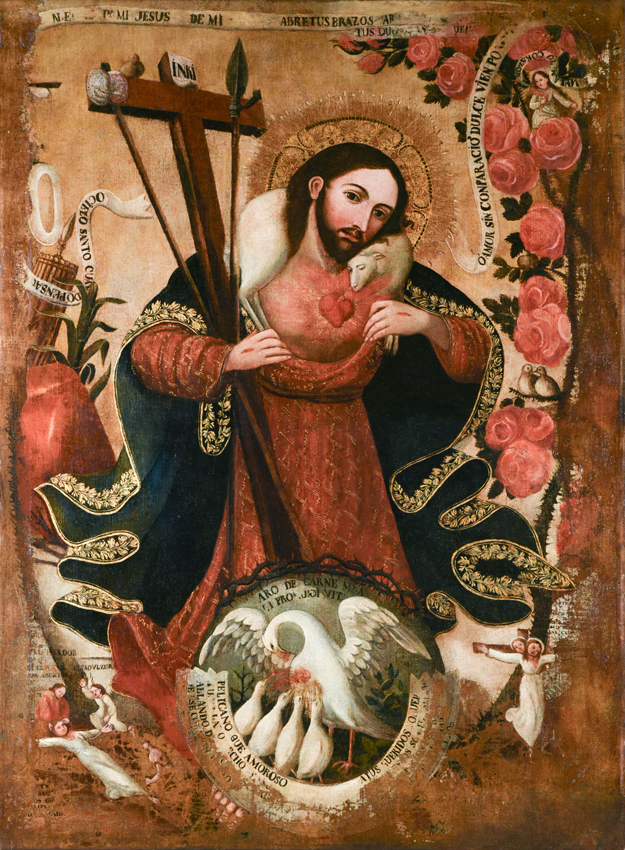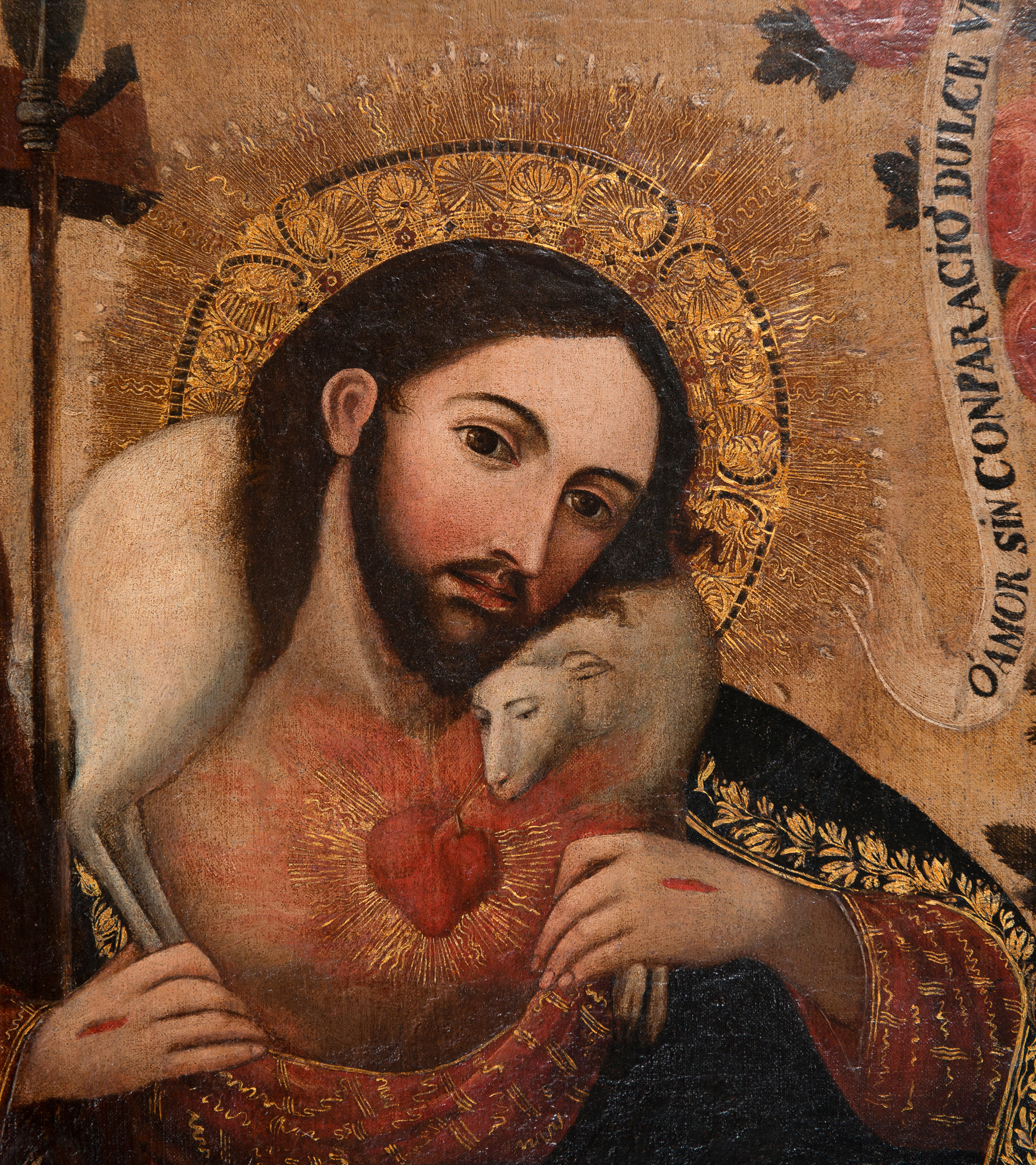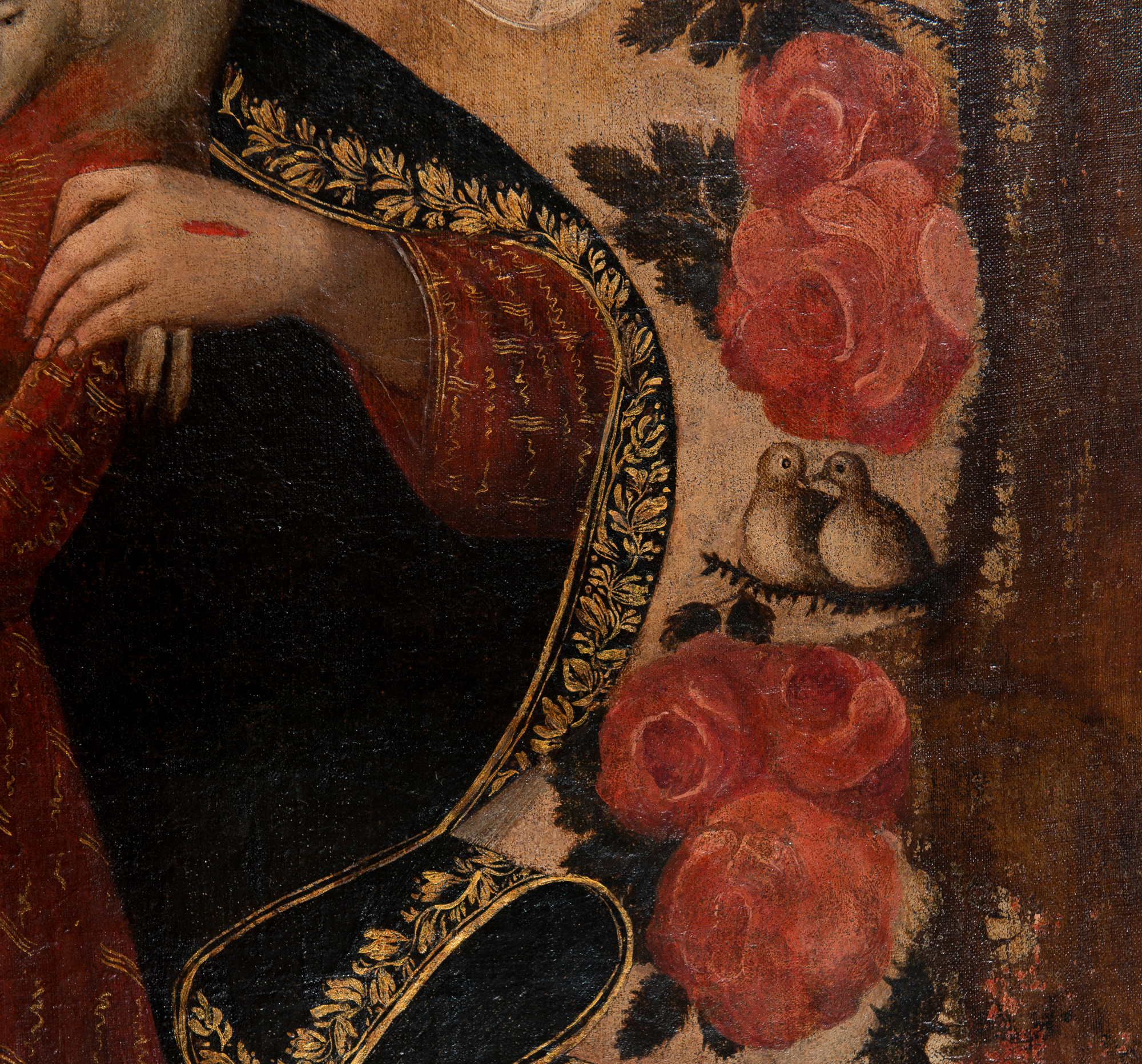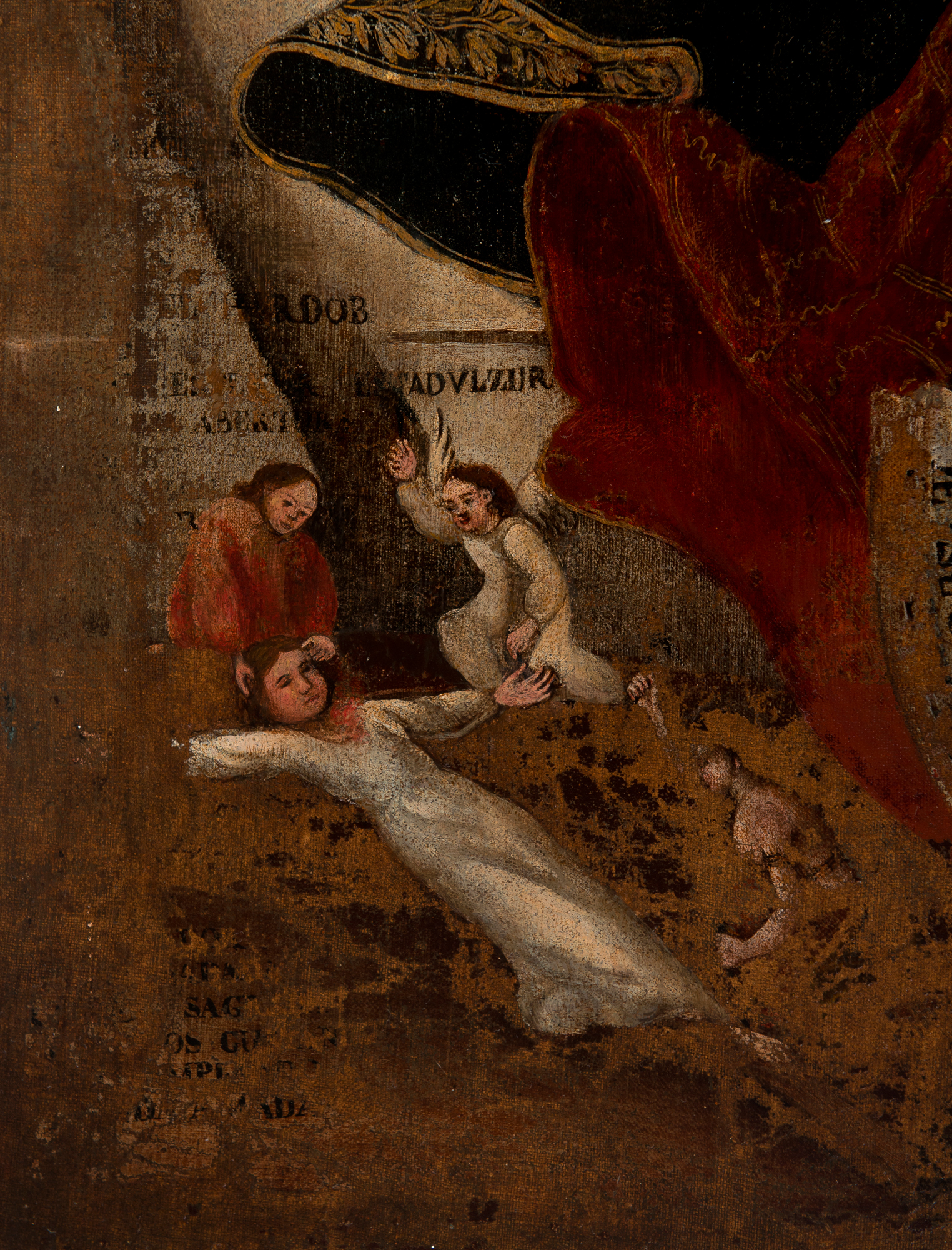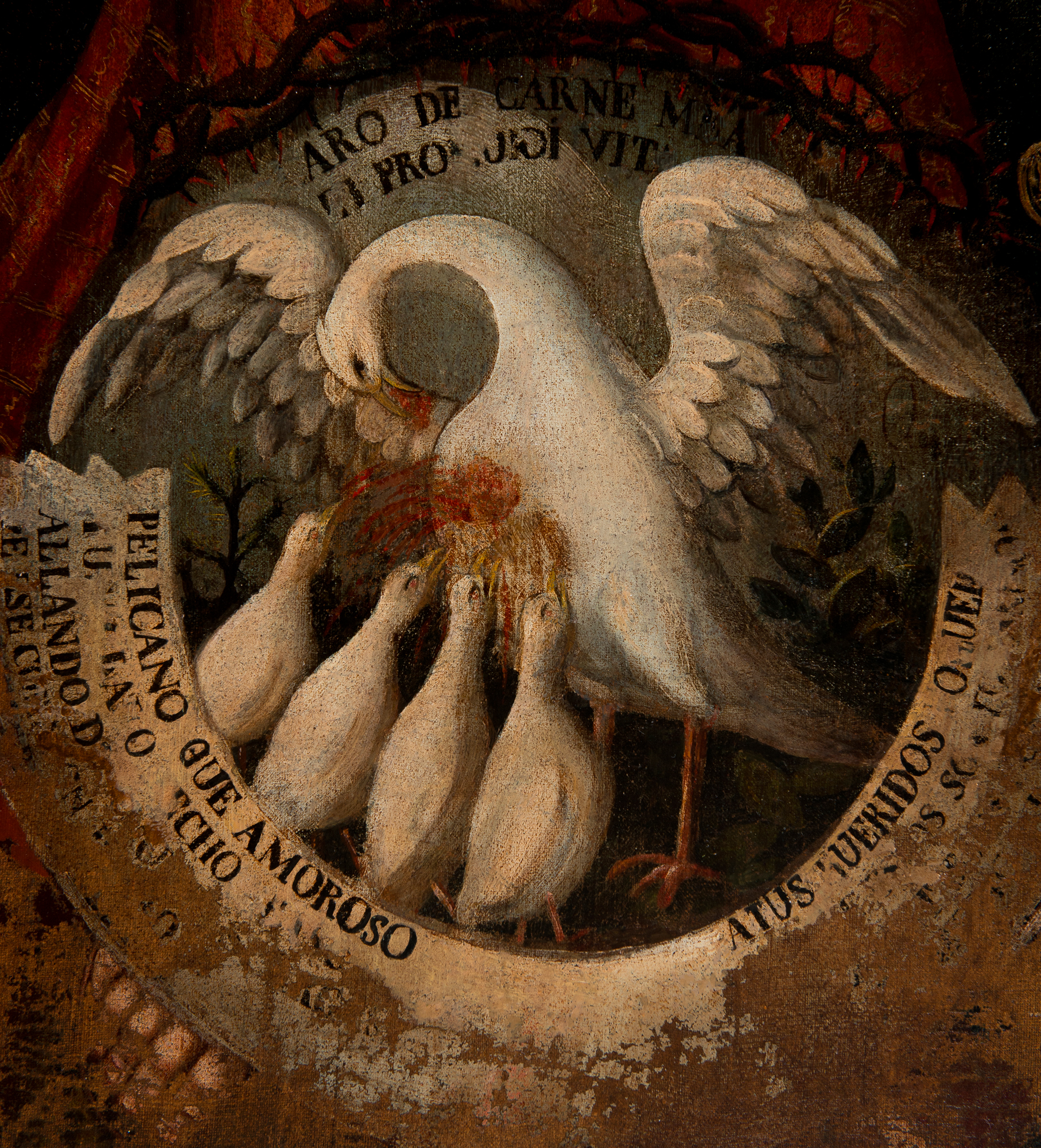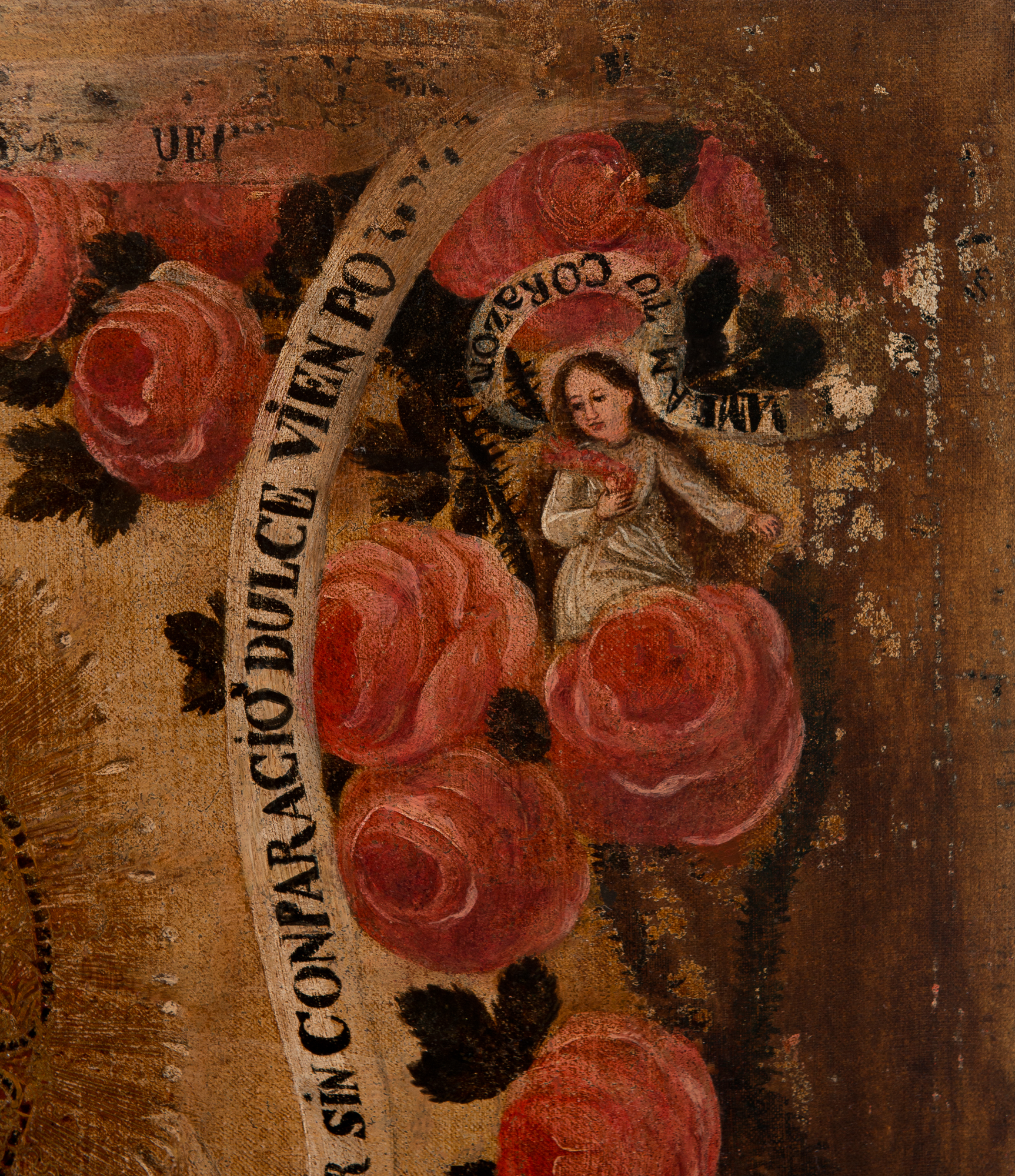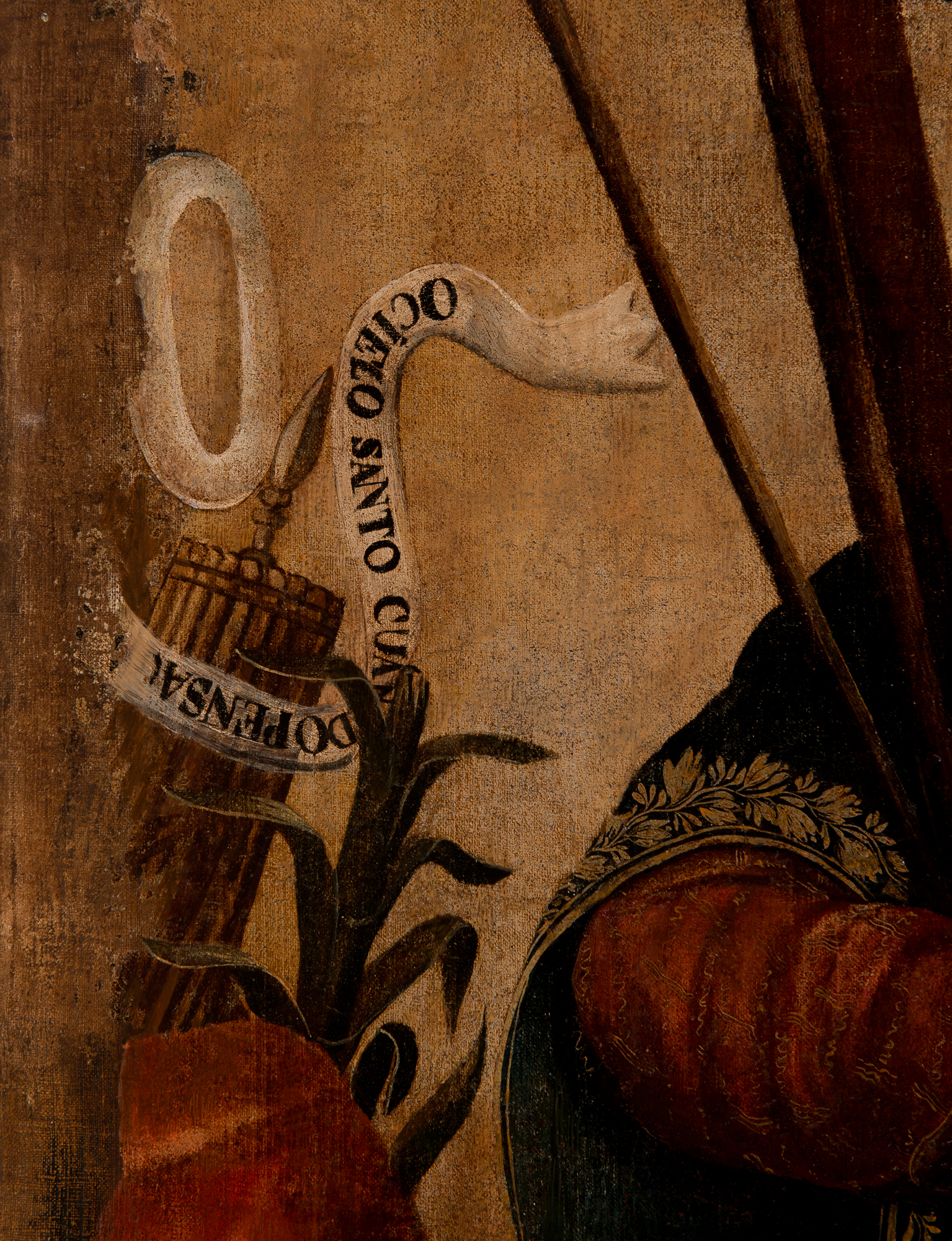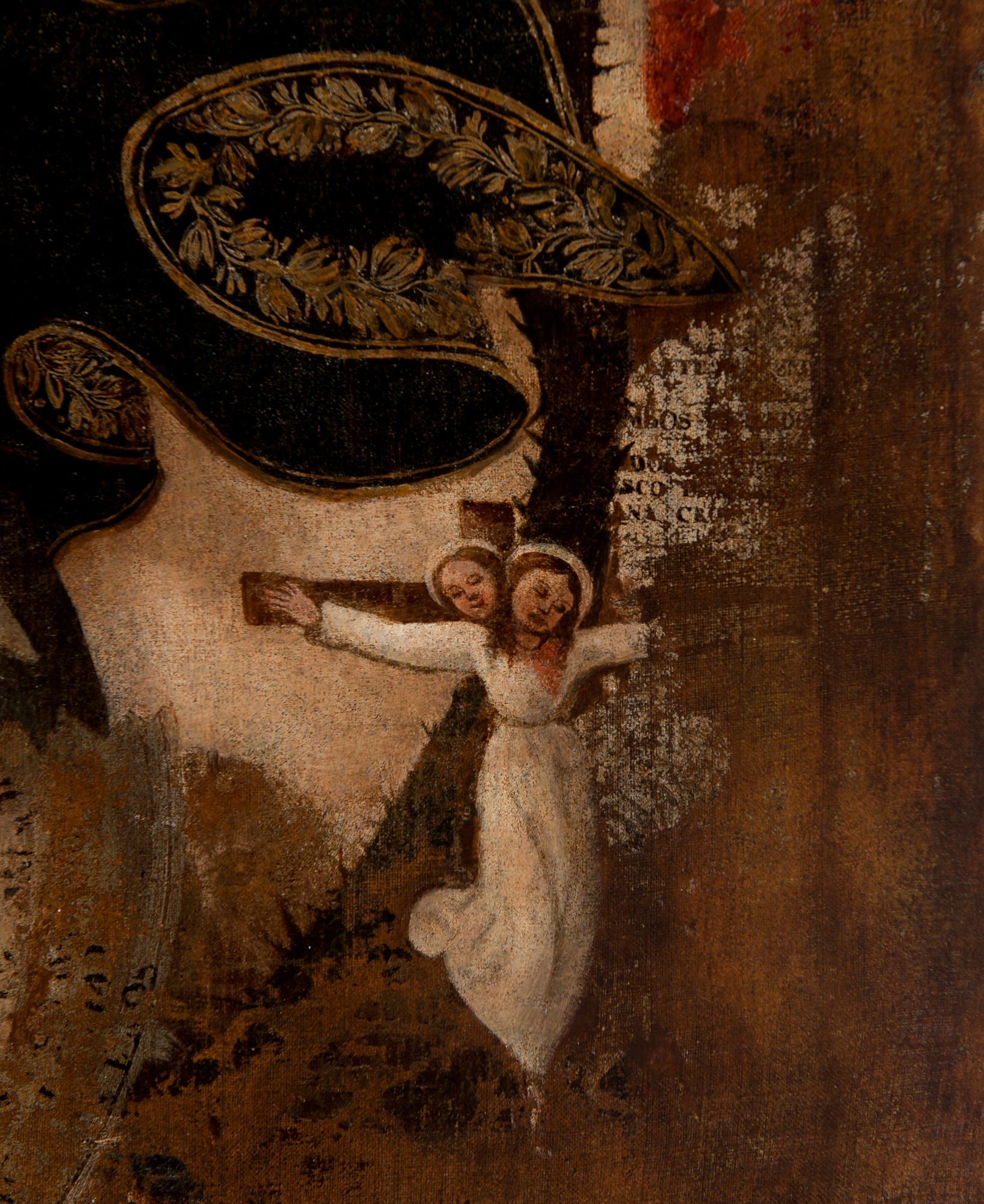46
Attributed to Isabel de Santiago (Real Audiencia of Quito, circa 1660/1670 - 1714)
Attributed to Isabel de Santiago (Real Audiencia of Quito, circa 1660 / 1670 - 1714)
‘Allegory of the Good Shepherd"
Oil on canvas.
95 x 70 cm.
Beautiful painting from Cuzco, with all the chromatic richness and detail of this school, representing the image of the Good Shepherd, an image already used in the early days of Christianity, loaded with symbolism, representing aspects of the new doctrine through which the Christian message was being spread, that not everyone received well: unconditional love, forgiveness, giving one's life for others, meekness and humility.
Deeply catechetical in nature, this painting shows in image and word ‘truths that had to be spread’ with tenderness and warmth, such as the image of a shepherd looking for the lost sheep and returning it to the flock after carrying it on his shoulders, a clear allusion to the biblical passage in John 10:11-16: ‘I am the Good Shepherd who lays down his life for his sheep’.
The figure of the Good Shepherd in general was inspired by ancient Christian iconography. Clear examples are the figure that appeared in the Catacomb of Priscilla (3rd century), a young man dressed in the style of the Greek shepherds, carrying a sheep on his shoulders, with two others at his feet looking on.
This image goes back to the Cyrophoros, already present in Mesopotamian art, a bearded man carrying a sheep on his chest; or the Hermes-Cyrophoros (ca. 325 AD) with another sheep on his back; or the Muscophoros, from Greek art, the young man who carried sacrificial animals on his shoulders.
The Lord as the Good Shepherd appears in this canvas standing full-length, in an engraved red tunic, with a shepherd's cloak, carrying a tame and enraptured lamb on his shoulders, showing his open chest with the symbolism of the ‘heart that gives its life unconditionally for its sheep’, which is offered lovingly and through suffering, with the attributes of the Passion: ‘I give myself and my life’.
At his feet is the symbol of the Pelican, wrapped in the crown of thorns, piercing its chest with its beak to feed its young with its blood, a clear symbol of Christ sacrificing Himself for humanity and of the Eucharist.
Loose phrases alluding to this iconography are distributed like phrases of a prayer, but their total interpretation is impossible due to losses through wear. However, they still give meaning: ‘O Holy Heaven, when we think ......’; ‘for my Jesus of my...’; ‘open your arms..., your sweet...’; ‘O Love without comparison, Sweet Good...’; ‘unite me to your heart...’; ‘Pelican that loving... to your dear ones...’.
From the crown of thorns with the pelicans inside, a rose bush loaded with red roses is born, symbolising the pain of Christ's Passion and martyrdom in general, red roses that are a symbol of love with a clear veiled message: ‘I love you’. The blood of Jesus shed on the cross has also become a symbol of earthly love.
Finally, on the rose bush, two turtle doves appear in a pair, as a universal symbol of love, fidelity, hope, marriage or union, peace, serenity and protection.
This painting shows exquisite taste for art reflected in each brushstroke, as Isabel de Santiago was the daughter of the famous painter Miguel de Santiago, from whom she would inherit her gifts and qualities for art, besides being one of the very few women who achieved recognition in the era of development of Spanish-American viceroyalty art. The artist was attracted to painting from a very young age, a passion she shared also with her second husband. She began to train and work in Santiago's workshop as a teenager. She would later become its the owner and worked there with her husband. She was widowed in the early 1700s and in 1706 she continued painting until the day of her death, which occurred in Quito in 1714. She was buried in the Convent of La Merced, near her home. This convent is where her best known painting is found, the postumous portrait she painted of Sister Juana de Jesús, a Poor Clare nun, to whom they attributed the saintly behavior.
This episode, recounted by biographer Francisco Javier Antonio de Santa María, reinforces Isabel's singular talent. After the nun's death, her husband Antonio Egas, unable to paint the portrait, delegated the task to Isabel, who managed to capture the essence of Sor Juana based solely on her memory. This fact evidences not only Isabel's technical skill, but also her capacity for empathy and spiritual understanding, qualities that are also reflected in our Tota Pulchra, where the figure of the Virgin exudes unequaled serenity and majesty.
In the painting that we describe we see her personal stylistic marks, floral beauty, the luminosity conveyed in each brushstroke and the presence of minuscule details, almost like those seen under a magnifying glass, which are always present in all her artworks. This painting is very reminiscent of two others of hers: “Our Lady of Roses”, which she painted for the convent of Santo Domingo, and “Our Lady of Flowers”, which is in the Colonial Art Museum of Quito. There is also a painting of the Archangel Saint Gabriel in which the flowers and gilded decoration underline the celestion majesty of the subject, just like the painting we have here. This painting is also a canvas worthy to be placed in any museum.
The use of gold by Isabel de Santiago, applied on large surfaces and in minute detail, gives her works an unusual brilliance even within the context of the Quito School, where gold was common but rarely used with such delicacy.
Her life, marked by humility and devotion, reflects the silent but constant struggle of the women artists of her time, who managed to transcend gender barriers and leave a lasting legacy. In Tota Pulchra, Isabel de Santiago not only depicts the Virgin as Queen of Heaven, but also reveals herself as a visionary artist, capable of capturing a deeply spiritual vision of art.
Reference bibliography:
- Martín Martín, Inmaculada. (2010). “El pintor quiteño Miguel de Santiago (1633-1706)”: Universidad de Sevilla.
- Martín Martín, Inmaculada. (2007). “Leyendas de un artista. A propósito del pintor quiteño Miguel de Santiago”. Publicado en: “De Arte” N.º 6.
“Isabel de Santiago: una pintora quiteña del siglo XVII” Inmaculada Martín Martín.Publicado en: “De Arte” N.º 7, 2008.
- Escudero-Albornoz, Ximena y Escudero de Teránz, Ximena. (1992). “América y España en la escultura colonial quiteña: historia de un sincretismo”. Ediciones del Banco de los Andes.
- Borchart de Morenoz, Christiana Renate. (1998). “La Audiencia de Quito: aspectos económicos y sociales (siglos XVI-XVIII)”. Editorial Abya Yala.
Attributed to Isabel de Santiago (Real Audiencia of Quito, circa 1660 / 1670 - 1714)
‘Allegory of the Good Shepherd"
Oil on canvas.
95 x 70 cm.
Beautiful painting from Cuzco, with all the chromatic richness and detail of this school, representing the image of the Good Shepherd, an image already used in the early days of Christianity, loaded with symbolism, representing aspects of the new doctrine through which the Christian message was being spread, that not everyone received well: unconditional love, forgiveness, giving one's life for others, meekness and humility.
Deeply catechetical in nature, this painting shows in image and word ‘truths that had to be spread’ with tenderness and warmth, such as the image of a shepherd looking for the lost sheep and returning it to the flock after carrying it on his shoulders, a clear allusion to the biblical passage in John 10:11-16: ‘I am the Good Shepherd who lays down his life for his sheep’.
The figure of the Good Shepherd in general was inspired by ancient Christian iconography. Clear examples are the figure that appeared in the Catacomb of Priscilla (3rd century), a young man dressed in the style of the Greek shepherds, carrying a sheep on his shoulders, with two others at his feet looking on.
This image goes back to the Cyrophoros, already present in Mesopotamian art, a bearded man carrying a sheep on his chest; or the Hermes-Cyrophoros (ca. 325 AD) with another sheep on his back; or the Muscophoros, from Greek art, the young man who carried sacrificial animals on his shoulders.
The Lord as the Good Shepherd appears in this canvas standing full-length, in an engraved red tunic, with a shepherd's cloak, carrying a tame and enraptured lamb on his shoulders, showing his open chest with the symbolism of the ‘heart that gives its life unconditionally for its sheep’, which is offered lovingly and through suffering, with the attributes of the Passion: ‘I give myself and my life’.
At his feet is the symbol of the Pelican, wrapped in the crown of thorns, piercing its chest with its beak to feed its young with its blood, a clear symbol of Christ sacrificing Himself for humanity and of the Eucharist.
Loose phrases alluding to this iconography are distributed like phrases of a prayer, but their total interpretation is impossible due to losses through wear. However, they still give meaning: ‘O Holy Heaven, when we think ......’; ‘for my Jesus of my...’; ‘open your arms..., your sweet...’; ‘O Love without comparison, Sweet Good...’; ‘unite me to your heart...’; ‘Pelican that loving... to your dear ones...’.
From the crown of thorns with the pelicans inside, a rose bush loaded with red roses is born, symbolising the pain of Christ's Passion and martyrdom in general, red roses that are a symbol of love with a clear veiled message: ‘I love you’. The blood of Jesus shed on the cross has also become a symbol of earthly love.
Finally, on the rose bush, two turtle doves appear in a pair, as a universal symbol of love, fidelity, hope, marriage or union, peace, serenity and protection.
This painting shows exquisite taste for art reflected in each brushstroke, as Isabel de Santiago was the daughter of the famous painter Miguel de Santiago, from whom she would inherit her gifts and qualities for art, besides being one of the very few women who achieved recognition in the era of development of Spanish-American viceroyalty art. The artist was attracted to painting from a very young age, a passion she shared also with her second husband. She began to train and work in Santiago's workshop as a teenager. She would later become its the owner and worked there with her husband. She was widowed in the early 1700s and in 1706 she continued painting until the day of her death, which occurred in Quito in 1714. She was buried in the Convent of La Merced, near her home. This convent is where her best known painting is found, the postumous portrait she painted of Sister Juana de Jesús, a Poor Clare nun, to whom they attributed the saintly behavior.
This episode, recounted by biographer Francisco Javier Antonio de Santa María, reinforces Isabel's singular talent. After the nun's death, her husband Antonio Egas, unable to paint the portrait, delegated the task to Isabel, who managed to capture the essence of Sor Juana based solely on her memory. This fact evidences not only Isabel's technical skill, but also her capacity for empathy and spiritual understanding, qualities that are also reflected in our Tota Pulchra, where the figure of the Virgin exudes unequaled serenity and majesty.
In the painting that we describe we see her personal stylistic marks, floral beauty, the luminosity conveyed in each brushstroke and the presence of minuscule details, almost like those seen under a magnifying glass, which are always present in all her artworks. This painting is very reminiscent of two others of hers: “Our Lady of Roses”, which she painted for the convent of Santo Domingo, and “Our Lady of Flowers”, which is in the Colonial Art Museum of Quito. There is also a painting of the Archangel Saint Gabriel in which the flowers and gilded decoration underline the celestion majesty of the subject, just like the painting we have here. This painting is also a canvas worthy to be placed in any museum.
The use of gold by Isabel de Santiago, applied on large surfaces and in minute detail, gives her works an unusual brilliance even within the context of the Quito School, where gold was common but rarely used with such delicacy.
Her life, marked by humility and devotion, reflects the silent but constant struggle of the women artists of her time, who managed to transcend gender barriers and leave a lasting legacy. In Tota Pulchra, Isabel de Santiago not only depicts the Virgin as Queen of Heaven, but also reveals herself as a visionary artist, capable of capturing a deeply spiritual vision of art.
Reference bibliography:
- Martín Martín, Inmaculada. (2010). “El pintor quiteño Miguel de Santiago (1633-1706)”: Universidad de Sevilla.
- Martín Martín, Inmaculada. (2007). “Leyendas de un artista. A propósito del pintor quiteño Miguel de Santiago”. Publicado en: “De Arte” N.º 6.
“Isabel de Santiago: una pintora quiteña del siglo XVII” Inmaculada Martín Martín.Publicado en: “De Arte” N.º 7, 2008.
- Escudero-Albornoz, Ximena y Escudero de Teránz, Ximena. (1992). “América y España en la escultura colonial quiteña: historia de un sincretismo”. Ediciones del Banco de los Andes.
- Borchart de Morenoz, Christiana Renate. (1998). “La Audiencia de Quito: aspectos económicos y sociales (siglos XVI-XVIII)”. Editorial Abya Yala.
Millésime 25 · 20th anniversary of La Suite Subastas
Sale Date(s)
Venue Address
General delivery information available from the auctioneer
The purchase price includes the delivery of the lots in the venue of the auction. Transporting to other destinations is at the own risk of the client. The customer must contact "LST", to give the corresponding instructions for such transporting. "LST" is not responsible for the packaging or any accident incurred during transportation.
Important Information
It is important please, that you read our conditions of sale before the auction. If you need us to send them to you by mail, just ask for them.
We would like to remind you that in compliance with Spanish historical heritage laws, lots over 100 years old will need a license, which we will take care of processing for you. This process can take up to a month, as the Ministry of Culture holds only one meeting per month.
The Spanish administration does not charge anything for clients within the European Community, but for non-European Community buyers, the Spanish administration does apply fees. Please contact us for more details on the cost of these fees.
Terms & Conditions
CONDITIONS OF THE AUCTION:
I. REGISTRATION. To bid in the room customers must register at the beginning, filling out a form and picking a number that will identify them during the auction. Customers may be required to register in bank references or other guarantee system and if they do not prove the solvency "LST" will not accept bids and award the auction.
II. WRITTEN BIDS. "LST" will accept written bids, which will be formalized in the form provided by the room until the day before the auction. In such auctions, the room will bid in name of the client until the maximum stated in the offer and always at the lowest possible price. If there are two or more bids for the same amount, the one placed first will have the priority. Written bids received in advance, will have priority on the day of the auction.
III. TELEPHONE BIDS. "LST" will allow telephone bids, if interested people contact "LST" days before the auction providing personal data, ID card and the phone number which will be used by the staff of "LST" to call at the time of the auction. The buyer, within all the legal rights is making an offer for the asking price, when applies for telephone bid. "LST" will not take responsibility for any technical defects beyond its control, which may prevent to contact successfully the bidder during the auction.
IV. AUCTIONEER. The auction will be conducted by an auctioneer, director of the auction will be judge and arbitrator of it with full authority in its development, will award the lots to the highest bidder and is able to settle any controversy concerning lots sale, reject bids, divide lots or group them and remover objects from the room. Will be able to, if it is deemed suitable, not accept bids on the auction. His decision will be unappealable.
V. SALE OF LOTS. The lots are awarded to the highest bidder. Once the auctioneer blows the hammer, the buyer becomes responsible of the lot purchased, exempting "LST" of liability to for any damage and / or accidents that may occur. No refunds of lots.
VI. STARTING PRICE. The amount shown in the catalogue as the starting price for each lot will be, as a rule, the minimum selling price, except for exceptional cases where a reservation may be agreed upon with the seller or it set discretionary by the room.
VII. SCALE OF BIDS. The bids are set according to the following scale:
From 50.-€ to 200.-€…………………………………………..at 10.-€
From 200.-€ to 500.-€…………………………………… …25 in 25.-€
From 500.-€ to 1.000.-€………………………………..…..….50 in 50.-€
From 1.000.-€ to 2.000.-€………………………………..…100 in 100.-€
From 2.000.-€ to 5.000.-€……………………………….….250 in 250.-€
From 5.000.-€ to 10.000.-€…………………………………500 in 500.-€
From 10.000.-€ to 20.000.-€……………………………1.000 in 1.000.-€
From 20.000.-€ to 50.000.-€……………………………2.500 in 2.500.-€
From 50.000.-€ to 100.000.-€…………………………..5.000 in 5.000.-€
From 100.000.-€ to 100.000.-€………………………10.000 in 10.000.-€
From 200.000.-€ to 200.000.-€………………………25.000 in 25.000.-€
From 500.000.-€ to 500.000.-€………………………50.000 in 50.000.-€
VIII. RIGHT OF ADMISION. "LST" reserves the right to admission to the auction room and to reject, at its judgment, any purchase order, from clients whose solvency is not duly proved as well as not to sale auctions.
IX. SALE PRICES. The successful bidder of one or more lots must pay "LST" the final sale price achieves at auction, plus the 24,5 % plus 21% VAT on the commission, at total 29,64 % on Hammer Price.
X. CATALOG DATA. The catalogue data are obtained in order to careful research and advice, however, any responsibility is afforded about its accuracy. The lots will be auctioned in the state in which they are, not accepting any claims in restorations, breakage, damage, imperfections and, even description or numbering mistakes in the catalogue, in case of it, being the burden of the buyers to make sure before the auction that the description matches with their personal opinion about respective lot. The exhibition of the lots is intended to allow a perfect review and study of them.
XI. PAYMENT AND REMOVAL OF LOTS. Payment and removal of the lots will be held no later than five days following the auction. After this period expire without having the buyer removed the lot or lots purchases, it will accrue an expense of custody of 6 euros per day on each lot.
15 days after the auction without having the buyer paid and removes the sold lots, "LST" will inform the seller and there will begin judicial proceeding in order to obtain payment. The delay in payment by the purchaser of his/her sold lots will carry an interest increase at a rate of 1,5% per month.
XII. DELIVERY OF LOTS. The purchase price includes the delivery of the lots in the venue of the auction. Transporting to other destinations is at the own risk of the client. The customer must contact "LST", to give the corresponding instructions for such transporting. "LST" is not responsible for the packaging or any accident incurred during transportation.
XIII. RIGHT OF FIRT REFUSAL AND REPURCHASE. "LST" in order to article 38 of "Ley 16/1985 de 25 Junio del Patrimonio Histórico Español" (BOE. 155 June 29, 1985), will notify in advance to the Ministry of Culture, the content of their catalogues. Concerning the lots subject to the legislation referred to in the preceding paragraph, the Administration may exercise the rights of first refusal and repurchase according to the law. "LST" will watch over the protection of Artistic, Historical and Bibliographical Heritage of Spain. For customers out of European Community, a tax for export is required by the Administration.
XIV. EXPORT LICENSE. In compliance with Spanish historical heritage laws, lots over 100 years old need a export license, which we will take care of processing for you. The Spanish administration does not charge anything for clients within the European Community, but for non-European Community buyers, the Spanish administration does apply fees. Please contact us for more details on the cost of these fees.
XV. VALUE ADDED TAX (I.V.A). This tax will be accrued on commissions of "LST" for buyers, using the rates prevailing on the date of the auction.
XVI. DATA PROTECTION. In order to the "Ley 15/1999 de 13 de Diciembre, de Protección de Datos de Carácter Personal", the client authorize "LST", the inclusion of their data in a customer file, and for the promotion by "LST" of the objects at all times the rights of access, rectification or deletion of personal data by sending the appropriate request to the following address: LA SUITE SUBASTAS, C/ Conde Salvatierra, 8, 08006. Barcelona.
XVII. EXPRESS LEGAL JURISDICTION. These Conditions are governed by and interpreted in accordance with the rules of Spanish law. The mere act of participating in the auction as seller, buyer or bidder, implies acceptance of these Terms and Conditions.
Sales operations are understood to be held at the registered office of "LST", C/ Conde de Salvatierra, 8, 08006. Any dispute shall be taken to the competent courts of Barcelona, expressly waiving any other jurisdiction, in accordance with Article 55 of the "Ley de Enjuiciamiento Civil".






















